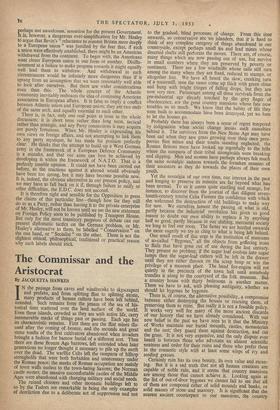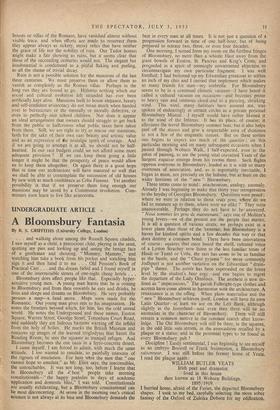The Commissar and the Aristocrat
By JACQUETTA HAWKES IN the passage from caves and windbreaks to skyscrapers and prefabs, and from splitting flint to splitting atoms, many products of human culture have been left behind, stranded. Such remains form the jetsam of the sea of his- torical time scattered over the land surface of the world. Even these islands, crowded as they are with active life, carry innumerable marks of things past or passing. Each age has its characteristic remains. First there are the flint mines dis- used after the coming of bronze, and the mounds and great stone tombs of the first cultivators abandoned when invaders brought a fashion for barrow burial of a different sort. Then there are these Bronze Age barrows, left untended when later generations no longer thought it necessary to pile up the earth over the dead. The warlike Celts left the ramparts of hilltop strongholds that were both forbidden and unnecessary under the Roman peace; the marks of Roman occupation are mainly of town walls useless to the town-hating Saxons; the Norman castle mottes, the massive uncomfortable castles of the Middle Ages were abandoned with changing military and social needs. The ruined cloisters and other monastic buildings left to us by the Tudors are remarkable in being the only examples of dereliction due to a deliberate act of suppression and not to the gradual, blind processes of change. From this time onwards, so conservative are we islanders, that it is hard to think of any complete category of things abandoned in our countryside, except perhaps small tin and lead mines whose deserted shafts still perforate the moors. There are, of course, many things which are now passing out of use, but survive in small numbers where they are preserved by poverty or sentiment. There are a few windmills whose sails still turn among the many where they are fixed, reduced to stumps, or altogether lost. We have all heard the slow, creaking turn of a watermill, seen the vanes come up thick with green slime and hung with bright fringes of falling drops, but they are now very rare. Paramount among all these survivals from the pre-industrial age already touched by the grey finger of obsolescence, are the great country mansions whose fate now troubles us so much. We know that the habits of life they were built to accommodate have been destroyed, yet we hate to let the houses go.
Probably there has always been a sense of regret tempered by indignation when social change leaves such casualties behind it. The survivors from the New Stone Age may have been sad when they saw grass growing over their once pros- perous flint mines and their tombs standing neglected; the Roman Britons must have looked up regretfully to the hills where the ramparts of their tribal strongholds were breaking and slipping. Men and women have perhaps always felt much the same nostalgic sadness towards the forsaken remains of their ancestors as they do towards the places of their own youth. Yet the nostalgia of our own time, our interest in the past and longing to preserve its remains are far beyond what has been normal. To us it seems quite startling and strange, for instance, to discover from the journal of that diligent seven- teenth-century tourist Celia Fiennes the confidence with which she welcomed the destruction of old buildings to make way for new. We ourselves lament the passing of what is old, partly because the industrial revolution has given us good reason to doubt our own ability to replace it by anything half so good, partly because in our shifting, mercurial society we long to feel our roots. The faster we are hurtled onwards the more eagerly we try to cling to what is being left behind. One small result of this urge is the institution of museums of so-called " Bygones," all the objects from goffering irons to flails that have gone out of use during the last century. They present no problem; if the sugar loaf evolves into sugar lumps then the sugar-loaf cutters will be left in the drawer until they are either thrown on the scrap heap or win the privilege of a museum place. The hand fire-engine will rot quietly in the precincts of the town hall until somebody trundles it along to the courtyard of the folk museum. But a country house with thirty bedrooms is another matter. There we have to ask, with pleasing ambiguity, whether we should let bygones be bygones. There is, of course, the alternative possibility, a compromise between either destroying the houses or rescuing them, of preserving them as ruins. But really it is not a feasible policy. It works very well for many of the more ancient discards of our history that we have already considered. With our new belief in the past we have seen to it that the Ministry of Works maintain our burial mounds, castles, monasteries and the rest; they guard them against destruction, and cut the grass. It is not very expensive, and the only dispute ever heard is between those who advocate an almost scientific neatness and order for their ruins and those who prefer them in the romantic style with at least some wisps of ivy and seeding grasses. Certainly ruin has its own beauty, its own value and mean- ing. But it is a sad truth that not all human creations are capable of noble ruin, and it seems that country mansions are among those that cannot achieve it. Looking again at the list of out-of-door bygones we cannot fail to see that all of them are composed either of solid mounds and banks, or solid masses of stone and masonry. It is significant that the nearest ancient counterpart to our mansions, the country houses or villas of the Romans, have vanished almost without visible trace, and when efforts are made to resurrect them they appear always as rickety, messy relics that have neither :the grace of life nor the nobility of ruin. Our Tudor houses might make a fair showing as ruins, but it seems clear that those of the succeeding centuries would not. The elegant but insubstantial is condemned to a pitiful flaking and peeling, to all the shame of trivial decay.
Ruin is not a possible solution for the mansions of the last three centuries. We must preserve them or allow them to vanish as completely as the Roman villas. Perhaps in the long run they are bound to go. Hitherto nothing which our social and cultural evolution left stranded has ever been artificially kept alive. Mansions built to house elegance, luxury and self-confident aristocracy do not mean much when handed over to bureaucrats or the mentally or morally defective, or even to perfectly. nice school children. Nor does it appear an ideal arrangement that owners should struggle to get back from the public in halfcrowns what public taxes have taken from, them. Still, we are right to try to rescue our mansions, both for the sake of their own rare beauty and artistic value and as an expression of the nostalgic spirit of courage. And if we are 'going to attempt it at all, we should not be half- hearted. In our vast budgets could we not afford some more adequate provision ? If we can keep them going a little longer it might be that the prosperity of peace would. allow us to keep them altogether. Or again there is a good hope that in time our architecture will have matured so well that we shall be able to contemplate the succession of old houses by new with as much confidence as Celia Fiennes. Yet another possibility is that • if we preserve them long enough our mansions may be saved by a Communist revolution. Com- missars soon learn to live like aristocrats.



























































 Previous page
Previous page